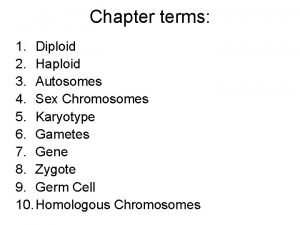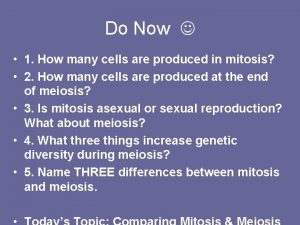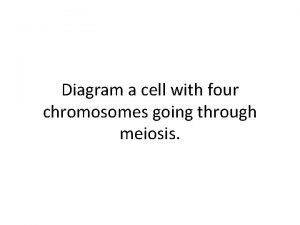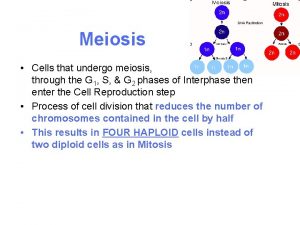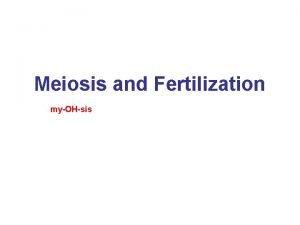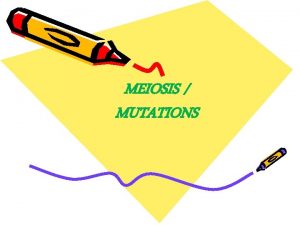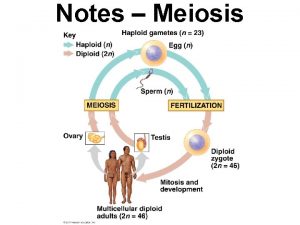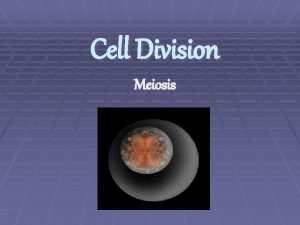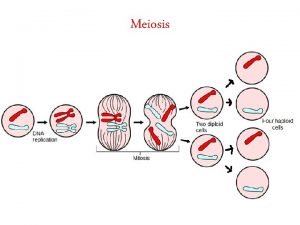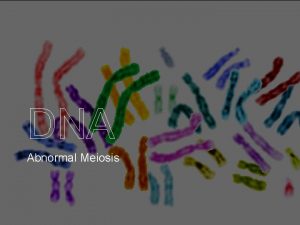Meiosis Why Do cells Go through Meiosis Cells


























- Slides: 26

Meiosis

Why Do cells Go through Meiosis? �Cells go through Meiosis in order to make Sex Cells �Sex cells are also called Gametes �Four Daughter Cells are created �Haploid (1 N)

Interphase �Cell Grows �Duplicates DNA �Cell Prepares to divide

After Interphase �In order to make sex cells or cells with half the number of chromosomes meiosis has TWO phases �Meiosis I and Meiosis II

Prophase I �Chromosomes Condense (visible) �Homologous chromosomes form a tetrad �Crossing Over Occurs

Crossing Over �Homologous Chromosomes- Similar Chromosomes, Same genes in the same location �When the chromosomes touch they switch genes �Causes genetic variation

Metaphase I �Homologous chromosomes move together to the middle of the cell �Spindle attaches to the centromere

Anaphase I �Homologous chromosomes separate �Sister chromatids stay attached �Move towards opposite poles

Telophase I �Division of cytoplasm �Creates Two daughter cells �Begin Meiosis II �There is no interphase II �Why?

Prophase II �Spindles re-appear �Nuclear membrane stays separated

Metaphase II �Chromosomes line up in the middle �Spindle attaches �How are metaphase I and II different?

Anaphase II �Sister Chromatids Separate from each other �How are Anaphase I and II different from each other?

Telophase II �Nucleus reforms �Division into four daughter cells �Haploid (1 N) �Gametes (egg and sperm)

Mitosis & the Cell Cycle

Cell Growth & Development Are cells of organisms the same size? Do your cells get bigger as you grow, or do you just produce more cells? n When talking about Cell Size…… Smaller is Better! n The larger a cell becomes, the more demands the cell places on its DNA, and the harder it is to supply with nutrients. n

Cell Division Before a cell becomes to large, a growing cell will divide. n Cell division is the process by which a Single cell divides into 2 Daughter cells. n Cell Division = the series of events that cells go through as they grow and divide. n

Chromosomes n n n Chromosomes= are composed of DNAWhich carries the cell’s coded genetic information. Humans have 46 chromosomes(23 pairs). The chromosomes consist of two identical sister chromatids.

Two Major Types of Cell Division n Mitosis- Somatic cells (Body Cells) n n Diploid 2 N Meiosis- Sex cells/ Gametes n Haploid 1 N

Mitosis is the process by which the genetic information is replicated and distributed to daughter cells. n 2 diploid(2 N) daughter cells are produced from 1 diploid (2 N) parent cell. n The Daughter cells are genetically identical to the parent cells. n There are 4 major stages to mitosis, Not including interphase. n

Interphase n Interphase= The cell spends most of its life here; not part of the actual reproduction. NOT PART OF MITOSIS. Cell grows and replicates its DNA and centriole n Nuclear membrane is visible n Nucleus, Nucleoli, and chromatin can be seen. n

Interphase

Prophase n Prophase: first phase of Mitosis n n Nuclear membrane breaks down Chromosomes become visible n Centrioles separate n Spindle forms

Metaphase n Metaphase: Second part of Mitosis n n Chromosomes attach to spindle Chromosomes line up across the MIDDLE of the cell

Anaphase n Anaphase: Third step in Mitosis n The sister chromatids separate and move apart towards opposite poles

Telophase n Telophase: Fourth stage of Mitosis n n n Chromosomes gather at opposite ends of the cell The nuclear membrane begins to form and enclose the chromosomes Cell membrane begins to move inwards

Cytokinesis n n n Cytokinesis: Final stage in cellular division Not Mitosis Works with telophase n n The cytoplasm divides completely in half. 2 daughter cells with identical genetic information are produced.
 Why why why why
Why why why why Why did robert hooke name cells “cells”?
Why did robert hooke name cells “cells”? Dont ask
Dont ask Meiosis i vs meiosis ii
Meiosis i vs meiosis ii Tetrad meiosis
Tetrad meiosis Crossing over occurs during
Crossing over occurs during Differentiate between chromosome and chromatid
Differentiate between chromosome and chromatid Study guide chapter 10 section 1 meiosis
Study guide chapter 10 section 1 meiosis Chapter 10 section 10.2 meiosis worksheet answer key
Chapter 10 section 10.2 meiosis worksheet answer key Meosis prophase 2
Meosis prophase 2 Diploid vs haploid
Diploid vs haploid Does meiosis 1 produce haploid cells
Does meiosis 1 produce haploid cells How many cells are produced in meiosis? *
How many cells are produced in meiosis? * Meiosis
Meiosis Whats a gamete
Whats a gamete Meiosis
Meiosis Diagram a cell with 4 chromosomes going through meiosis
Diagram a cell with 4 chromosomes going through meiosis Development of paranasal sinuses
Development of paranasal sinuses Loop of henle
Loop of henle Thyroid parafollicular cells
Thyroid parafollicular cells How are somatic cells different from gametes
How are somatic cells different from gametes Why dna is more stable than rna
Why dna is more stable than rna Chlorocruorin
Chlorocruorin Prokaryotic vs eukaryotic transcription worksheet
Prokaryotic vs eukaryotic transcription worksheet Venn diagram for animal and plant cells
Venn diagram for animal and plant cells Prokaryotic cell
Prokaryotic cell Masses of cells form and steal nutrients from healthy cells
Masses of cells form and steal nutrients from healthy cells










